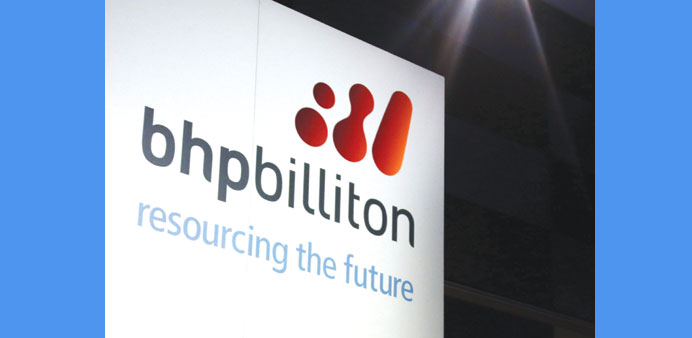The jump in BHP Billiton’s shares after profits plunged shows a mindset akin to buying tickets for the Titanic’s second voyage because the gash in the hull from striking the iceberg isn’t as bad as feared.
By Clyde Russell /Launceston, Australia
The jump in BHP Billiton’s shares after profits plunged shows a mindset akin to buying tickets for the Titanic’s second voyage because the gash in the hull from striking the iceberg isn’t as bad as feared.
BHP’s Australian-listed stock jumped almost 3% on Tuesday to close at A$33.06, and extended gains to A$33.54 in early trade in Sydney yesterday, a three-month high.
The world’s biggest mining company posted a 31% drop in half-year underlying attributable profits to $5.35bn, but this was ahead of the consensus forecast of $5.1bn.
An increase in the interim dividend to $0.62 a share was also ahead of market forecasts, and this goes a long way to explaining the boost in the share price.
But delve deeper into BHP’s results for the half-year ended December 31 and the impact of the rout in commodity prices becomes more apparent, as does the prospect of even lower profits in coming reporting periods.
Even Chief Executive Andrew Mackenzie adopted a sombre tone, telling a call with analysts that the price of iron ore, the miner’s main commodity, was likely to remain under downward pressure as more supply comes to market.
“Although we see some loss of production, particularly from expensive Chinese iron ore (producers) ... we still see a growing surplus of low-cost supply and therefore, if anything, the pressure on the price is (still) downward,” he said.
It’s not just iron ore, which makes up half of BHP’s profits, that is under pressure, with crude, coal and copper prices also struggling as available supply outweighs demand.
It’s somewhat ironic that the best performing parts of BHP are the ones the company intends to spin off into a new company, to be called South 32. These include aluminium and manganese.
Going back to the positive market reaction to the BHP results, and it becomes clear that for this to be a sustained rally, investors will have to believe that the miner will be able to cut costs at faster pace than it loses revenue from lower commodity prices.
BHP, along with its main competitor Rio Tinto, has had great success in cutting costs, and said in its presentation on Tuesday that it’s on track to meet its target of $4bn of productivity gains by the 2017 fiscal year. Lower exploration spending will also help free up cash flow that can be used to meet the promise of higher dividends. But the company was also quite clear that cost savings get harder to find and the process can’t go on indefinitely.
However, commodity prices may not play ball, and further declines will hit revenues.
BHP said the average realised price for iron ore was $70 a tonne in its fiscal first half. This was down 38% from the same period a year earlier. But the main problem is that Asian spot iron ore prices have weakened further since the second half of 2014, falling to $63.40 a tonne just ahead of the Lunar New Year holidays. Each $1 change in the price of iron ore has an approximate impact of $140mn on net profit, BHP said in the presentation.
For oil, a $1 per barrel move in price has an impact of $50mn, for coking coal $1 per tonne equals $30mn, while for copper 1 US cent per pound has an impact of $30mn.
While the price of coking coal has recovered somewhat in recent weeks, at about $103 per tonne, it’s still below the $110 level that prevailed around the middle of last year.
It’s the same story for crude oil and copper, with both posting some small gains in recent weeks, but remaining well below the levels in the second half of 2014.
This can only mean downward pressure on BHP’s revenues, raising the risk that the company may disappoint investors expecting dividends to continually rise.
BHP concluded its presentation by stating the company had the correct strategy and was in “great shape”. It’s hard to argue about the success BHP has achieved in driving down costs, improving productivity and increasing output of key commodities.
But all this good work can still be undone by low commodity prices, and the outlook for iron ore and coal remains poor, at best crude oil may recover slightly and gains in copper look somewhat uncertain.
Investors took the massive slump in profits at BHP and Rio, where underlying profit for the six months ended December dropped 30%, in their stride.
Another big profit slide in six months’ time may dent that confidence, and instead focus the market on the limits to cost-cutting. For the miners, they must be hoping for some kind of recovery in commodity prices before they reach the limits of cost-cutting.
But if BHP and Rio are going to trade as stocks investors buy for juicy dividends, it seems they are more risky propositions than the big banks and telecommunications giant Telstra that are the current dividend champs on the Australian Stock Exchange.
Clyde Russell is a Reuters columnist. The views expressed are his own.

